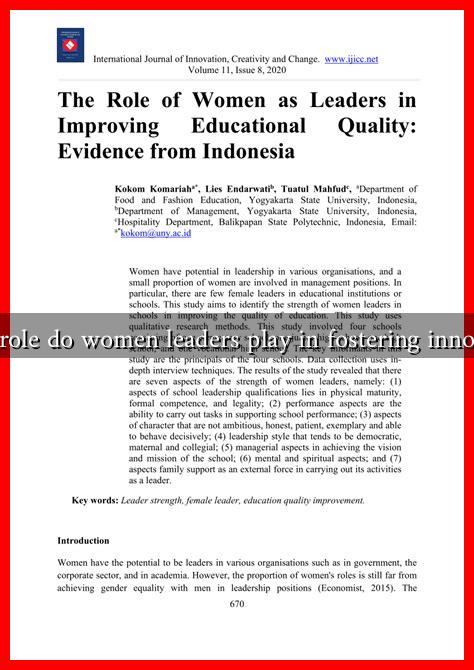-
Table of Contents
- What Role Do Women Leaders Play in Fostering Innovation?
- The Unique Perspective of Women Leaders
- Key Contributions of Women Leaders to Innovation
- Case Studies of Women Leaders Driving Innovation
- Statistics Highlighting the Impact of Women Leaders
- Conclusion: The Future of Innovation with Women Leaders
What Role Do Women Leaders Play in Fostering Innovation?
In today’s rapidly evolving business landscape, innovation is a key driver of success. As organizations strive to stay ahead of the competition, the role of leadership becomes increasingly critical. Women leaders, in particular, have emerged as pivotal figures in fostering innovation across various sectors. This article explores the unique contributions of women leaders to innovation, supported by research, case studies, and statistics.
The Unique Perspective of Women Leaders
Women bring diverse perspectives and experiences to leadership roles, which can significantly enhance creativity and innovation within organizations. Research has shown that diverse teams are more innovative and effective. According to a study by McKinsey & Company, companies in the top quartile for gender diversity on executive teams are 21% more likely to experience above-average profitability.
Key Contributions of Women Leaders to Innovation
Women leaders contribute to innovation in several ways:
- Encouraging Collaboration: Women leaders often prioritize collaboration and teamwork, creating an environment where ideas can flourish. This collaborative spirit fosters open communication and encourages team members to share their thoughts freely.
- Emphasizing Empathy: Women tend to exhibit higher emotional intelligence, which allows them to understand and address the needs of their teams and customers. This empathetic approach can lead to innovative solutions that resonate with a broader audience.
- Risk-Taking and Resilience: Contrary to stereotypes, many women leaders are willing to take calculated risks. They often demonstrate resilience in the face of challenges, which is essential for driving innovation.
- Championing Diversity: Women leaders are more likely to advocate for diverse hiring practices, which can lead to a richer pool of ideas and perspectives. A diverse workforce is crucial for fostering creativity and innovation.
Case Studies of Women Leaders Driving Innovation
Several women leaders have made significant strides in fostering innovation within their organizations:
- Ginni Rometty – IBM: As the former CEO of IBM, Rometty championed the company’s shift towards cloud computing and artificial intelligence. Under her leadership, IBM invested heavily in research and development, resulting in numerous innovations, including Watson, the AI system that gained fame for winning on the quiz show Jeopardy!
- Mary Barra – General Motors: Barra has been instrumental in transforming GM into a leader in electric and autonomous vehicles. Her commitment to innovation is evident in the company’s significant investments in electric vehicle technology, positioning GM as a key player in the future of transportation.
- Reshma Saujani – Girls Who Code: As the founder of Girls Who Code, Saujani has been a strong advocate for closing the gender gap in technology. Her organization has empowered thousands of young women to pursue careers in tech, fostering a new generation of innovators.
Statistics Highlighting the Impact of Women Leaders
Several studies underscore the positive impact of women in leadership roles on innovation:
- A report by the Peterson Institute for International Economics found that having more women in leadership positions can lead to a 6% increase in profitability.
- According to a study published in the Harvard Business Review, companies with more women in leadership roles are 1.4 times more likely to be innovative.
- The World Economic Forum’s Global Gender Gap Report indicates that closing the gender gap in the workforce could add $28 trillion to the global economy by 2025.
Conclusion: The Future of Innovation with Women Leaders
Women leaders play a crucial role in fostering innovation within organizations. Their unique perspectives, collaborative approaches, and commitment to diversity contribute to a culture of creativity and forward-thinking. As businesses continue to navigate the complexities of the modern world, embracing women in leadership roles will be essential for driving innovation and achieving sustainable success.
In summary, the evidence is clear: organizations that prioritize gender diversity in leadership are better positioned to innovate and thrive. By supporting and promoting women leaders, companies can unlock new ideas and solutions that will shape the future of their industries.
For further reading on the impact of women in leadership, you can explore resources from McKinsey & Company and the World Economic Forum.

